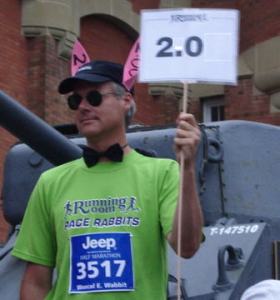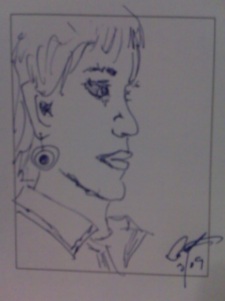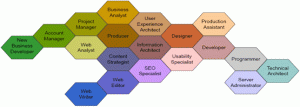January 13, 2012
I now return to irregularly scheduled postings
Posted by mjmclean under Uncategorized | Tags: #gov2.0, dreams, opengov, sxsw |Leave a Comment
December 1, 2010
Communicators – Find Your Gordon
Posted by mjmclean under social media, Web and Government | Tags: #gov2.0, communications, corrective blogging, governance, policy, social media |[4] Comments
Debates continue to swirl around the ‘ownership’ of social media. In government, we tend to equate ownership with resources (human and financial) but not necessarily with the appropriate insight, expertise or authority.
The ‘ownership’ of the execution of social media activities is quite simple – it involves horizontal collaboration based on the issue at hand, not which group you are a part of or to whom you report.
This became more clear to me during a social media pilot about online issues management and corrective blogging. Stakeholders working on the pilot (policy, communications, advocacy, media relations and web communications) emerged from their respective offices to participate. Who ‘owned’ it? We all did. From planning, training and online responding, we all played a part.
I recently spoke about the methodology and outcomes of this pilot at a Social Media for Government event in Ottawa. The speakers represented all levels of government and spoke on a variety of issues which provided diversity and balance in both experience and insight.
What wasn’t balanced was the audience. “How many of you are communicators or work in that field?” All but one hand shot into the air.
“How many of you are policy or program officers?” Tucked against the side wall was a lone hand reaching above the crowd.
Meet Gordon. Gordon was a policy officer working on a key file for his department. As someone from the “business side,” Gordon felt it was important for him to learn about possible uses and applications of social media.
I called on, or made reference to Gordon numerous times throughout my presentation and have continued to do so since. I was thrilled to have a policy officer in the room for it is the policy (file, service etc.) that our social media efforts support. We need to have regular contact with the people who are closest to the heart of an issue and its messages, challenges and audience in order to best know how social media might help.
Social media for, or in government needs to be about more than ownership and include discussions amongst more than communicators.
What’s your next step? Find your Gordon!
Onward.
M.
Disclosure: Gordon confided in me after my presentation that he actually wore two hats – policy and communications! If only we could all be so lucky Gordon ;)
September 24, 2010
Roadblocks – they’re not worth selling!
Posted by mjmclean under OnlineOdyssey | Tags: #cpsr, bureaucracy, change management, community, management |[2] Comments
I love new co-op students. They come in with fresh ideas, inquisitive minds and interesting perspectives on the public service. 
After only two weeks on the job, our most recent student remarked that he is starting to understand the “pace you folks need to work at” in order to get things done.
Clearly diplomacy is already something he has learned. After some prodding it became clear he has already met one of the government’s more familiar entities, the roadblock!
That’s life in the government, get used to it. Sadly that is ‘advice’ given to freely and without thought of the possible effects that will have, especially on those just starting out or considering a career in the public service.
Don’t sell them folks. I have a little more faith in what we can do for it is not the ‘government’ that puts these roadblocks in place, it is us, the public servants.
And so, over coffee, my simple comments to him – if there’s a road being blocked, find a way:
- Can you move it on your own? Take a bit of time and energy and do it.
- Will it take more than you have? Find someone to help you – maybe work is already underway that will make it easier.
- A little more substantial? Get a group willing and make it happen.
- And the kicker – no matter how many people have try, is it going to require more? Find the person(s) responsible for putting, or keeping it there and work it out. Perhaps it is no longer needed or does not need to be as obstructive? Can the size be downgraded from a roadblock to a speedbump?
A simple breakdown but does it really need to be more complex? I was happy our discussion then led to the importance and value of collaboration, community and tools that can always help.
But, at the heart of it is the recognition that each of us can and should do what we can to make the road ahead smooth and better for those yet to come.
Of course a smart question followed, wouldn’t it be easier to build a new road? Perhaps, but it that always better?
Onward.
M.
May 21, 2010
It’s a marathon – find your pace bunny and settle in
Posted by mjmclean under Uncategorized, Web and Government | Tags: collaboration, management, web2.0 |[13] Comments
 Over the last decade or so of my toiling away in the government online world, I’ve often joked about the need for web champions to don capes and prowl the halls bringing attention to the potential of the web and the ‘super’ people bringing our sites to life.
Over the last decade or so of my toiling away in the government online world, I’ve often joked about the need for web champions to don capes and prowl the halls bringing attention to the potential of the web and the ‘super’ people bringing our sites to life.
My thinking has evolved. Gone are my longing for capes – it’s now time for the pace bunnies! The gun’s been fired and departmental wikis, internal blogs and online communities are all off and running. Settle in folks, this is a long marathon, not a sprint.
There are some who were already out on the course when these tools appeared at work. Others are happy to try and keep pace and improve along the way while some will forever be trailing behind.
Now, I’m neither an expert nor an early adopter – I have labelled myself as a “utility adopter.” I’m in it for the long haul but still look to those setting the pace up ahead to keep me in the pack.
Through my use and championing of our internal blog, which serves as a litmus test for our readiness to share, other teams have asked that I share my experience and help show them how these tools might help their work, which I’m happy to do.
It all boils down to the same thing – know your audience. I won’t grow frustrated with those lacing up their shoes for the first time, it’s a refreshing jog for me and I always learn something. I’m energized by those ready to speed up a little bit and really test the road. And for those who are ready to leave the pack, I’ll likely point them to the pace bunny ahead and wish them well.
Are you a pace bunny or do you need one?
Onward,
M.
February 1, 2010
Whither Web 1.0?
Posted by mjmclean under Web and Government | Tags: governance, government, social media, web 1.0, web 2.0 |[5] Comments
With Gov2.0 LA days away where open gov, cloud computing, gov2gov collaboration and more will be discussed, I find myself increasingly, and ironically speaking and championing more and more Web 1.0.
Yes, it would seem that despite my Gov 2.0 attachments and engagements I am a Web 1.0 champion. Now, to profess, it is the 2.0 world that has my heart but my mind continues to play tricks and reminds me that the 1.0 foundation, albeit less ‘sexy’ now, is one that has often been left unfinished.
In 1999, the Government of Canada launched its “Government On-line” (GOL) initiative supported by over $800 million over a six-year period. The intention was to create a:
…service improvement initiative that will provide citizens and businesses with on-line access to the most commonly used Government of Canada information and transactional services via the Internet and in the official language of their choice.”
This is Web 1.0 in its simplest of iterations. I was a working in government web communications at this time. There were no experts, and if there were, finding them was no easy task. It was every person (for web teams were a rarity) for him or herself. Funding was in place; portals were developed; Common Look and Feel for government websites was born.
Canada was regarded as a leader in government online communications, accessibility, and web services. Those of us in government departments working in web communications were also grappling with how to use these new tools to communicate with our citizens. Sounds familiar doesn’t it?
Where were we? Over 6 years ago we were provided with clear, simple guidelines and checklists to guide Web evaluation, performance and client satisfaction among other things. Business planning, UX, public opinion research, analytics and evaluation, translation frameworks, CMS workflow, editorial planning and strategies – have we properly laid and nurtured these foundations? I believe many of us toiling away in the 2.0 world in government are experiencing frustrations not solely because of the new tools and associated fears, but because many of us are trying to build on a shaky, unfinished foundational layer.
Regardless of what is new, old, hot, traditional or proven, we cannot forge ahead without ensuring our starting point and the path behind us remain clear and maintained. I’m an avid user, fan and champion of the web 2.0 tools and, more importantly, the vast potential they possess to be game-changers in how we govern, communicate, influence and effect change.
Resource, maintain, and improve upon 1.0….this foundation is vital to the 2.0, 3.0 and citizen engagement movements.
And, if you’re not feeling my pain, then pass along the elixir!
Onward
M.
December 15, 2009
Will change do me, or you good?
Posted by mjmclean under Uncategorized | Tags: personal brand, social media, twitter, web 2.0 expo |[3] Comments
Update: With thanks to @bxmx it looks like “I’ll” be sticking around a little longer!
Change – for the most part I love it. Yet there are some things that just become comfortable and familiar.
And so it is that this was bound to happen.
“You totally need a new pic :P”
Yes, that’s the direct message I received via Twitter tonight. I laughed, as it’s likely true. I see those I follow changing their pics based on the season, their travels, a cause or campaign. Me, I stick with my hand drawn classic. It’s not flashy, it doesn’t render well and you can’t recognize me when you see me in person.
With a new year approaching perhaps it is time. Before doing that though, I thought I’d like to at least share my attachment before the chorus of “yes, please change it” grows louder.
Web 2.0 in San Francisco last March drove me onto Twitter and I haven’t looked back since. One of the challenges when I set up my profile was my pic. Fortunately, Nancy Duarte’s “Tools for Visual Storytelling” session provided the answer.
During the workshop, we were asked to turn to, and draw a sketch of the person next to us. My Twitter pic is the excellent 8 second result of the work of the person beside me. I snapped a pic, posted it and have comfortably settled into my hand drawn @mjmclean ever since. It resembles my, speaks to my online personality (I like a little mystery!) and reminds me every day about the value of personal connections.
Now knowing this, do I change? I know looking at the same pic, even washed out, could be frustrating so I’m nothing if not accommodating! ;)
Onward?
M.
December 11, 2009
2010 – year of the champions?
Posted by mjmclean under Uncategorized | Tags: gov 2.0, governance, management, social media |[2] Comments
“In an environment defined by tapered resource growth and increased demand for expertise we risk stretching our champions too far.”
I share those thoughts and agree with the challenges that risk poses. I am battle tested and at times, battle weary. Being a champion means being an ardent defender of your activities; to continually fight for what you know is right, or needed; and to lift those around us up, even if we ourselves feel down.
If we are in this for rewards, many are sure to exit early, become disenchanted or end up as casualties. With tongue in cheek I often say I’m a glutton for punishment for sticking with the government web scene as long as I have. The truth is, I love the challenge and the possibilities. It takes people willing to be those champions and to share those burdens who will help us all emerge relatively unscathed.
As one who appreciates my chats with Nick (above mentioned author,) his insights and commitment, and as one who has also felt at times that I’m being pulled and stretched, I offer up a year-end suggestion to all who have been toiling away in our government web world – it’s holiday time!

Fatigue should not give way to frustration. We are online longer, chatting more often, and constantlythinking and exploring. It’s time to preflect on the many successes and advances of the past year; re-evaluate; re-examine and recharge!
To my Canadian government colleagues – doesn’t it seem fitting for us to look forward to 2010 as our year as the champions?
Onward,
Martha
December 7, 2009
Judgement – Must have. Must Use.
Posted by mjmclean under Web and Government | Tags: #cpsr, bureaucracy, common sense, social media, TED, web 2.0 |Leave a Comment
TED came to Ottawa this weekend and in honour of thought-provoking talks, I’m sharing one of my all-time TED favourites by Barry Schwartz.
Mr. Schwartz demonstrates, via a story of unfortunate events, how society is run wild by bureaucracy.
As a public servant guided by common-sense, witnessing bureaucracy running wild in bureaucracy can often be confounding. Processes, rules and hierarchy have existed long enough that most neither question them, nor try to change them if they do.
For those of us working in online communications and social media in the Government – this is where our “practical wisdom” needs to shine. Many of us are the first or second generation Web leaders in Government. We are creating a new working order within the bureaucracy – where processes and rules don’t yet exist. It is in our experience and knowledge that we must have confidence and and rely on as we make decisions and set new directions every day.
Most of us don’t have senior managements to whom we look for guidance on Web 1.0 and 2.0 communications. In the absence of direction, or in the presence of misguided or misinformed direction, it is our judgement that should stand firm.
My rallying cry to you – use your judgement, regularly! And don’t forget, judgement is a section in your job description (for Canadian public servants.) Exercise it.
Onward.
Martha
August 27, 2009
Show-and-tell 2.0
Posted by mjmclean under Web and Government | Tags: bureaucracy, c-suite, gov 2.0, social media |[2] Comments
I recall with great fondness show-and-tell Fridays in kindergarten and grade 1. Fuzzy new slippers, a bunny, a kid sister and a bag of coconut are among those that stand out in my memory. Listening to my classmates only talk about their precious treasures would surely have instilled in me an early disdain for lectures or monologues.
In recent months, I’ve been called upon on numerous occasions to sell, show, define and defend social media, its worth and usage within and for our department. In doing so, I’m no longer armed with paper or a USB stick loaded with various powerpoint presentations or paper copies people can bury their noses in while I try to point out new and exciting ideas.
Presentations have moved away from the bullet lists and ‘catch alls’ for messaging to more succinct, albeit longer, visually appealing models. Any of you attending any 2.0 conferences, reading this or any other blog know the ones. What remains missing from these, however, is the excitement that generates from the good ‘ole show-and-tell.
The web is dynamic. Twitter streams are active. Video needs to be seen, not screen captured. Flash shouldn’t be seen in static form. The work I manage is online. Those features and new approaches we’re exploring are best showcased, not defined. Sadly, I can’t count on only one hand the number of “web” meetings I’ve participated in where the computer hasn’t been turned on.
The Web is dynamic and engaging – those of us charged with its development, management and evolution are enthusiastic and informed people.
Show it, talk about it and sell it.
Onward.
M.
August 11, 2009
Bureaucracy 2.0 – make sure your team is ready to stand and deliver
Posted by mjmclean under Web and Government | Tags: #cpsr, bureaucracy, gov 2.0, leadership, web governance |[6] Comments
I have long subscribed to the belief that our initiatives in the online communication world will eventually change the way the government functions. From our internal capacity to support a robust online environment to providing public servants with the general understanding and toolkit of web tools that can make them more effective, more than any time over the last decade I see the Gov2.0 movement starting to shape the new bureaucracy.
How does an organization this size manage this shift? As someone who manages an online communications team, I’ve seen numerous attempts to address this over the last years – major restructuring, semblances of web governance, decentralized management and ad hoc committees among them.
For my part, it means this; recognizing the landscape is shifting and that new skillsets have to be ushered in order to effectively, and professionally manage this facet of communications. This recognition and transformation takes time at an enterprise level. As those of us working in the 2.0 world well know, time is a precious commodity and months wasted can lead to missed opportunities.
And so, I recommend taking advantage of the lack of formal governance and work to shape it. If you’re in a position to influence a “2.0’ing” of the bureaucracy – do it! Those of us responsible for the advancement of the government’s online efforts are the ones best positioned to steer the course.
Create the positions you need, fill them with those ready and able to take on the challenges of an exciting and evolving environment and demonstrate your results, successes and opportunities for growth.
Over the last two years, my focus has been on building a team based not on traditional communication functions or by reshuffling personnel files. It has been a process of auditing positions, researching and rewriting job descriptions and having them reclassified to not only reflect the current tasks, but to also anticipate and support an unknown future in new media.
While I don’t have the number of positions available to me to build that ideal web team (at left) I remain hopeful that as the 2.o movement spreads, all communication positions will come under a microscope and go through similar exercises.
The web, in just over a decade of real existence in the government, is already at the 2.0 stage with 3.0 already seeping in. As a result, gone are the communication ‘generalists’ on my team. I’m extremely proud to now have a “community manager” on my team. While I won’t pretend to be the first to create such a position, it’s more than likely it’s still a rarity in an organization that should be ripe with them.
Web 2.0 government folk have long championed the need for senior leadership in order to create the foundations and make the advances necessary. While I don’t disagree with that, I think it will require leaders from all levels stepping up and affecting the change they are able to at their level. In this case, if senior managers want something new and dynamic, which they will, make sure your team is ready to stand and deliver.
Onward,
Martha


